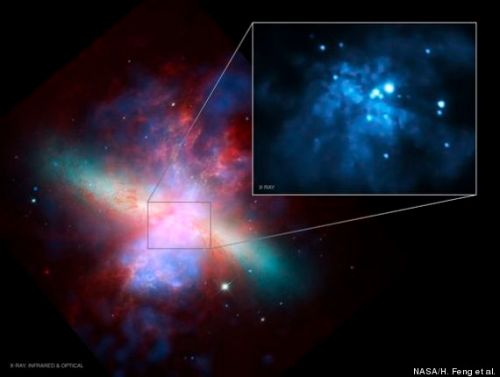
(An image of the Messier 82 galaxy showing the medium sized black hole M82 X-1 in the inset – Photo Credit: NASA/H. Feng et al)
For the first time, scientists have measured the mass of a medium sized black hole, confirming their highly debated existence.
Astronomers know that supermassive black holes, which can contain the mass of millions or even billions of stars, lurk at the heart of most galaxies. Additionally, much smaller black holes, which can contain just tens of stars’ worth of matter, are known to be scattered throughout the known universe.
In theory, there’s no reason that medium sized black holes shouldn’t exist as well, however until recently, noone had definitively found one.
Researchers had previously spotted hints of medium-sized black holes, which are thought to harbour between 100 and several hundred thousand solar masses, however they were unable to weigh these objects definitively, therefore their existence has been a matter of debate.
“Objects in this range are the least expected of all black holes,” said co-author of a study on medium sized black holes, Richard Mushotzky. “Astronomers have been asking, ‘Do these objects exist, or do they not exist? What are their properties?’ Until now, we have not had the data to answer these questions.”
That debate can now be put to rest.
A black hole in the nearby Messier 82 galaxy, which lies about 12 million light-years from Earth in the direction of the Big Dipper, has been with unprecedented precision, revealing that it is a medium black hole.
 (A mosaic image of the starburst Messier 82 galaxy – Photo Credit: NASA-ESA/AP)
(A mosaic image of the starburst Messier 82 galaxy – Photo Credit: NASA-ESA/AP)
About 15 years ago, NASA’s Chandra X-ray Observatory spacecraft spotted bright X-ray light streams being emitted from a source in the M82 galaxy. Mushotzky, and a team of colleagues, suspected that the object, called M82 X-1, was a medium-size black hole. But their suspicions could not yet be confirmed.
“For reasons that are very hard to understand, these objects have resisted standard measurement techniques,” Mushotzky said.
Mushotzky, and his team, took a closer look at M82 X-1, studying observations made between 2004 and 2010 by NASA’s Rossi X-ray Timing Explorer (RXTE) satellite, which ceased operations in 2012.
RXTE’s data allowed the team to determine the black hole’s mass. The researchers calculated M82 X-1’s mass at 428 suns, plus or minus 105 solar masses, placing M82 X-1 in the medium black hole classification group.
“In our opinion, and as the paper’s referees seem to agree, this is the most accurate mass measurement of an intermediate-mass black hole to date” announced University of Maryland doctoral student, Dheeraj Pashama, lead author of the study on M82 X-1.